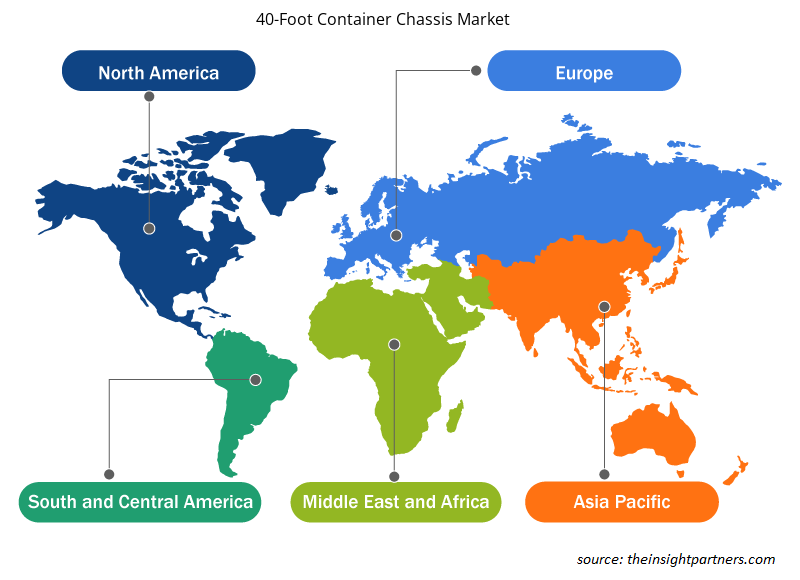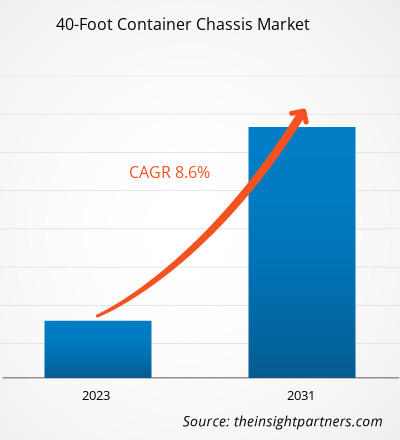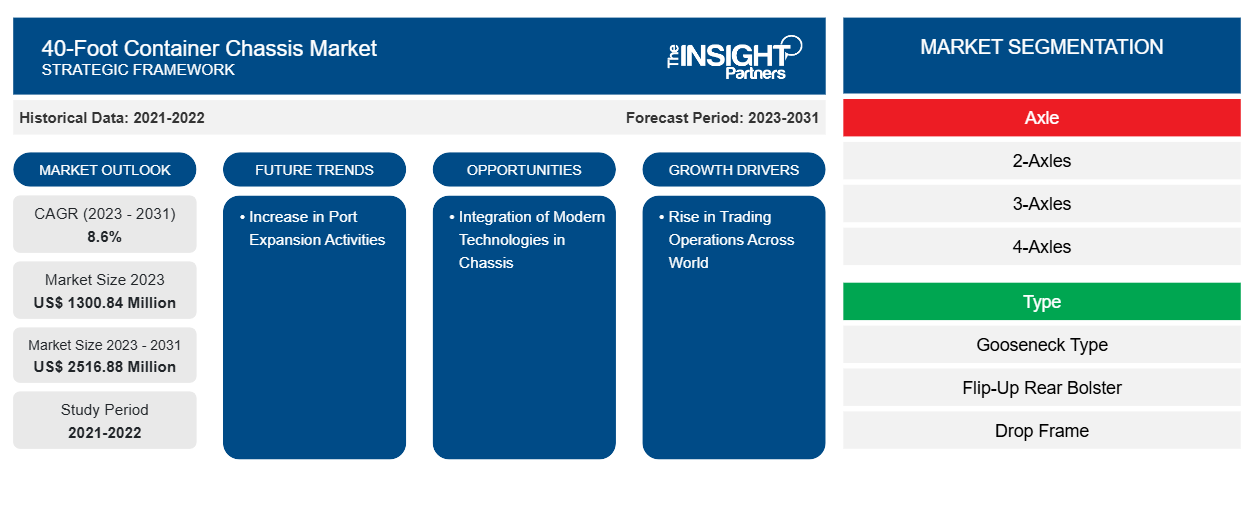Se proyecta que el tamaño del mercado de chasis de contenedores de 40 pies alcance los 2516,88 millones de dólares estadounidenses para 2031 desde los 1300,84 millones de dólares estadounidenses en 2023. Se espera que el mercado registre una CAGR del 8,6% en 2023-2031. La demanda de contenedores de 40 pies está creciendo con el aumento de las actividades comerciales en todo el mundo. Estos contenedores se utilizan para el envío nacional e internacional de mercancías de gran volumen debido a su capacidad para albergar una gran cantidad de carga. Teniendo en cuenta la creciente adopción de contenedores de 40 pies, los fabricantes están ampliando sus operaciones de fabricación, lo que impulsa la demanda de chasis para estos contenedores. Además, están lanzando nuevos productos con características adicionales para impulsar sus ingresos, ventas y base de clientes.
Análisis del mercado de chasis para contenedores de 40 pies
Los organismos reguladores y las regulaciones como la Administración Federal de Seguridad de Autotransportistas (FMCSA), el certificado de seguridad de contenedores (CSC) y la Organización Internacional de Normalización (ISO) tienen una fuerte influencia en la fabricación y venta de chasis para contenedores. En febrero de 2021, la Administración Federal de Seguridad de Autotransportistas (FMCSA) hizo cumplir su norma de chasis intermodal que requiere que los proveedores de equipos intermodales (IEP), los transportistas y los conductores compartan la responsabilidad de la seguridad de los equipos intermodales utilizados en las carreteras. Además, se prevé que las inversiones gubernamentales en infraestructura vial y de carreteras para mejorar la calidad de las carreteras, los ferrocarriles, los puertos y el transporte aéreo impulsen la demanda de chasis para contenedores en los próximos años. Una infraestructura de transporte mejorada impulsaría las operaciones logísticas en los sectores comercial e industrial, ayudando así a la entrega segura y oportuna de bienes y servicios. En marzo de 2023, el gobierno provincial de Terranova y Labrador anunció una inversión de aproximadamente US$ 1.400 millones para mejorar la infraestructura de transporte por carretera y autopista durante los próximos cinco años. En marzo de 2023, el gobierno del Reino Unido anunció planes de invertir ~US$ 43,50 mil millones (£ 40) en esquemas de transporte transformador en todo el país durante los próximos dos años. Los chasis de contenedores de 40 pies se utilizan en diversos medios de transporte comerciales e industriales. Por lo tanto, se proyecta que las inversiones gubernamentales para impulsar los segmentos comerciales e industriales de las economías mediante la mejora de la infraestructura vial y de carreteras ofrecerán oportunidades de crecimiento prometedoras para el mercado de chasis de contenedores de 40 pies durante el período de pronóstico.
Descripción general del mercado de chasis para contenedores de 40 pies
El mercado de chasis para contenedores de 40 pies es utilizado generalmente por proveedores de equipos intermodales (IEP), líneas navieras y transportistas, lo que implica el movimiento regional y local de contenedores en camiones. Los chasis se utilizan para mover contenedores desde las áreas de carga hasta el patio, así como a las áreas de almacenamiento en el patio, en las terminales. Los sistemas de chasis son fuertes y resistentes y protegen a los contenedores del impacto de movimientos bruscos y repentinos durante el tránsito, lo que garantiza un transporte eficiente y seguro.
Personalice este informe según sus necesidades
Obtendrá personalización en cualquier informe, sin cargo, incluidas partes de este informe o análisis a nivel de país, paquete de datos de Excel, así como también grandes ofertas y descuentos para empresas emergentes y universidades.
- Obtenga las principales tendencias clave del mercado de este informe.Esta muestra GRATUITA incluirá análisis de datos, desde tendencias del mercado hasta estimaciones y pronósticos.
Factores impulsores y oportunidades del mercado de chasis para contenedores de 40 pies
Aumento de las operaciones comerciales en todo el mundo
Según la Organización Mundial del Comercio (OMC), en 2022, el comercio mundial ha aumentado una media anual del 4% en términos de volumen y del 6% en términos de valor desde 1995. La globalización ha sido una de las principales razones del crecimiento del comercio mundial. El consiguiente aumento de la demanda de transporte de mercancías impulsa la necesidad de chasis portacontenedores para transportar contenedores de 40 pies. Además, el uso de estos chasis no se limita al traslado de mercancías por mar y tierra. También se utilizan para el traslado intermodal de contenedores a través de diferentes modos de transporte, como barcos, trenes y camiones. Por tanto, las actividades comerciales en continuo crecimiento en todo el mundo impulsan el crecimiento del mercado de chasis portacontenedores de 40 pies.
Integración de tecnologías modernas en el chasis
La integración de IoT en los sistemas de chasis ha facilitado una fuerte conectividad entre el chasis y otros componentes de una cadena de suministro, lo que lleva a una mejor visibilidad y seguimiento en tiempo real de la carga en teléfonos o computadoras. Es probable que IoT se extrapole a estos chasis para mejorar su eficiencia. Además, se percibe que las tecnologías avanzadas como la telemática tienen varios beneficios cuando se integran con chasis intermodales. La telemática puede mantener al personal actualizado al ofrecer información sobre la salida y llegada del chasis, lo que resolvería disputas de facturación y evitaría robos. También ayuda a una mejor gestión de las cadenas de suministro y las redes de transporte de mercancías.
Análisis de segmentación del informe de mercado de chasis de contenedores de 40 pies
Los segmentos clave que contribuyeron a la derivación del análisis del mercado de chasis de contenedores de 40 pies son el tipo y el eje.
- Según el tipo, el mercado se divide en 2 ejes, 3 ejes y 4 ejes. El segmento de 2 ejes tuvo una mayor participación de mercado en 2023.
- Según el tipo, el mercado mundial de chasis para contenedores de 40 pies se divide en chasis de cuello de cisne, chasis trasero abatible, chasis recto y chasis abatible. El segmento de chasis de cuello de cisne tuvo una mayor participación de mercado en 2023.
Análisis de la cuota de mercado de los chasis de contenedores de 40 pies por geografía
Según la geografía, el mercado de chasis para contenedores de 40 pies de América del Norte está segmentado en Estados Unidos, Canadá y México. La región es pionera en la adopción y expansión de sus capacidades comerciales para satisfacer la creciente demanda de los clientes. Con la globalización, existe una creciente demanda de bienes y servicios transportados a través de las fronteras internacionales. Las actividades de importación y exportación en la región están aumentando. Por ejemplo, según la Oficina de Análisis Económico, las actividades de importación y exportación entre Estados Unidos y China aumentaron en 2022 en comparación con 2021. Por lo tanto, este aumento del comercio de mercancías requiere grandes contenedores y chasis para transportar las mercancías desde los puertos y almacenes. Para atender dicha demanda, los actores del mercado están tomando iniciativas estratégicas para impulsar las ventas de chasis para contenedores de 40 pies. Por ejemplo, en junio de 2022, GIC, OMERS Infrastructure y Wren House adquirieron conjuntamente Direct Chassis Link Inc. (DCLI), una empresa de arrendamiento de chasis en Estados Unidos. Esta adquisición fortalecerá las capacidades de DCLI para llegar a más clientes y aprovechar el apoyo constante de GIC, OMERS Infrastructure y Wren House. Además, los actores del mercado están construyendo nuevas unidades de fabricación de chasis para atender la creciente demanda de chasis en medio del problema de escasez de chasis en los EE. UU. Por ejemplo, en octubre de 2020, CIE Manufacturing (CIEM), con sede en California, inauguró su nueva planta de fabricación de chasis en Virginia y lanzó su primer chasis para contenedores. El objetivo de construir esta planta de fabricación era fabricar chasis capaces de transportar contenedores intermodales de 40 pies y 40/45 pies. Además, CIEM amplió su planta de fabricación de California en 2020. En marzo de 2022, TRAC Intermodal se asoció con American Made Chassis (AMC) para fabricar y suministrar nuevos chasis para contenedores marítimos de 40 pies. Las asociaciones estratégicas entre los actores del mercado para fabricar chasis para contenedores de 40 pies conducen a una mayor colaboración en las capacidades de diseño, fabricación y distribución de los actores del mercado, lo que ayuda a impulsar el crecimiento del mercado de chasis para contenedores de 40 pies en América del Norte.
Perspectivas regionales del mercado de chasis para contenedores de 40 pies
Los analistas de Insight Partners explicaron en detalle las tendencias y los factores regionales que influyen en el mercado de chasis para contenedores de 40 pies durante el período de pronóstico. Esta sección también analiza los segmentos y la geografía del mercado de chasis para contenedores de 40 pies en América del Norte, Europa, Asia Pacífico, Medio Oriente y África, y América del Sur y Central.

- Obtenga datos regionales específicos para el mercado de chasis de contenedores de 40 pies
Alcance del informe de mercado de chasis de contenedores de 40 pies
| Atributo del informe | Detalles |
|---|---|
| Tamaño del mercado en 2023 | US$ 1300,84 millones |
| Tamaño del mercado en 2031 | US$ 2516,88 millones |
| CAGR global (2023 - 2031) | 8,6% |
| Datos históricos | 2021-2022 |
| Período de pronóstico | 2023-2031 |
| Segmentos cubiertos | Por eje
|
| Regiones y países cubiertos | América del norte
|
| Líderes del mercado y perfiles de empresas clave |
|
Densidad de actores del mercado: comprensión de su impacto en la dinámica empresarial
El mercado de chasis para contenedores de 40 pies está creciendo rápidamente, impulsado por la creciente demanda de los usuarios finales debido a factores como la evolución de las preferencias de los consumidores, los avances tecnológicos y una mayor conciencia de los beneficios del producto. A medida que aumenta la demanda, las empresas amplían sus ofertas, innovan para satisfacer las necesidades de los consumidores y aprovechan las tendencias emergentes, lo que impulsa aún más el crecimiento del mercado.
La densidad de actores del mercado se refiere a la distribución de las empresas o firmas que operan dentro de un mercado o industria en particular. Indica cuántos competidores (actores del mercado) están presentes en un espacio de mercado determinado en relación con su tamaño o valor total de mercado.
Las principales empresas que operan en el mercado de chasis para contenedores de 40 pies son:
- Chasis King Inc.
- Fliegl Fahrzeugbau GmbH
- Corporación de chasis Cheetah
- Triton Internacional Ltd.
- Karl Kassbohrer Fahrzeugwerke GmbH
- Fabricación CIE
Descargo de responsabilidad : Las empresas enumeradas anteriormente no están clasificadas en ningún orden particular.

- Obtenga una descripción general de los principales actores clave del mercado de chasis para contenedores de 40 pies
Noticias y desarrollos recientes del mercado de chasis para contenedores de 40 pies
El mercado de chasis de contenedores de 40 pies se evalúa mediante la recopilación de datos cualitativos y cuantitativos posteriores a la investigación primaria y secundaria, que incluye publicaciones corporativas importantes, datos de asociaciones y bases de datos. A continuación, se incluye una lista de los avances en el mercado en materia de innovaciones, expansión comercial y estrategias:
- En abril de 2022, Triton incorpora TAL Chassis a su marca principal. La empresa siguió centrándose en el arrendamiento a plazo de chasis y en las ventas directas a clientes que buscan soluciones flexibles y de bajo coste y estructuras de arrendamiento pensadas e innovadoras. (Fuente: Triton, comunicado de prensa)
- En abril de 2022, Kässbohrer y CM Logistik Gruppe establecieron una nueva colaboración con 40 vehículos portacontenedores multifuncionales con chasis extensible central y trasero K.SHG AMH. (Fuente: Kässbohrer, nota de prensa)
Informe de mercado sobre chasis de contenedores de 40 pies: cobertura y resultados
El informe “Tamaño y pronóstico del mercado de chasis para contenedores de 40 pies (2021-2031)” proporciona un análisis detallado del mercado que cubre las siguientes áreas:
- Tamaño del mercado de chasis de contenedores de 40 pies y pronóstico a nivel global, regional y nacional para todos los segmentos de mercado clave cubiertos por el alcance.
- Dinámica del mercado, como impulsores, restricciones y oportunidades clave
- Tendencias del mercado de chasis para contenedores de 40 pies
- Análisis detallado de las cinco fuerzas de Porter y PEST y FODA
- Análisis del mercado de chasis de contenedores de 40 pies que cubre las tendencias clave del mercado, el marco global y regional, los principales actores, las regulaciones y los desarrollos recientes del mercado
- Panorama de la industria de chasis de contenedores de 40 pies y análisis de la competencia que cubre la concentración del mercado, análisis de mapas de calor, actores destacados y desarrollos recientes.
- Perfiles detallados de empresas
- Análisis histórico (2 años), año base, pronóstico (7 años) con CAGR
- Análisis PEST y FODA
- Tamaño del mercado, valor/volumen: global, regional y nacional
- Industria y panorama competitivo
- Conjunto de datos de Excel
Informes recientes
Informes relacionados
Testimonios
Razón para comprar
- Toma de decisiones informada
- Comprensión de la dinámica del mercado
- Análisis competitivo
- Información sobre clientes
- Pronósticos del mercado
- Mitigación de riesgos
- Planificación estratégica
- Justificación de la inversión
- Identificación de mercados emergentes
- Mejora de las estrategias de marketing
- Impulso de la eficiencia operativa
- Alineación con las tendencias regulatorias





















 Obtenga una muestra gratuita para - Mercado de chasis para contenedores de 40 pies
Obtenga una muestra gratuita para - Mercado de chasis para contenedores de 40 pies